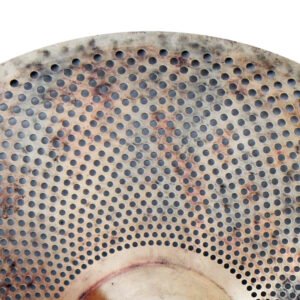Nearly 70% of drummers cite improper cymbal mounting as a leading cause of equipment damage and poor sound quality. When you’re setting up your drum kit, you’ll need to master the art of tying cymbal straps to protect your investment and achieve ideal resonance. While various mounting methods exist, the traditional leather or nylon strap remains the most versatile solution. Understanding the proper technique will guarantee your cymbals perform at their peak and last for years to come.
Key Takeaways
Thread the strap through both holes in the cymbal, ensuring equal length on each side.
Make a square knot by crossing the straps and looping them through twice.
Adjust tension so cymbal can swing freely while maintaining about 1/2 inch of vertical movement.
Place felt washers between the strap and cymbal to prevent metal-on-metal contact.
Test the setup by gently lifting the cymbal – it should move slightly but remain securely attached.
Understanding Cymbal Straps and Their Purpose
Cymbal straps are essential leather or synthetic fasteners that secure cymbals to their stands while allowing proper movement and resonance during play. You’ll find two primary cymbal strap types: traditional leather straps and modern synthetic alternatives made from materials like nylon or polyester.
The strap functionality centers on achieving the perfect balance between security and mobility. When properly tied, these straps let your cymbals swing freely while preventing them from falling off during intense performances. You’ll notice that each strap features pre-cut slots or holes that accommodate different cymbal sizes and mounting preferences.
Understanding your cymbal straps‘ material properties is vital for maintenance and performance. Leather straps offer traditional feel and durability but require occasional conditioning, while synthetic straps resist moisture and maintain consistent tension. You’ll need to take into account your playing style, venue conditions, and maintenance preferences when selecting between these options.
Essential Tools and Materials Needed
You’ll need either leather or nylon cymbal straps, which are available in pre-cut lengths or continuous rolls for custom sizing. For leather straps, you should have basic leather-working tools including a hole punch, utility knife, and measuring tape. The installation requires mounting hardware like washers, felts, and wing nuts that match your cymbal stand’s threading specifications.
Basic Cymbal Strap Types
There are three primary types of cymbal straps you’ll need to familiarize yourself with: leather straps, nylon straps, and pull-through straps. Each type offers distinct advantages depending on your playing style and preferences.
| Strap Type | Durability | Best Use Case |
|---|---|---|
| Leather | High | Professional/Studio |
| Nylon | Medium | Practice/Gigging |
| Pull-through | Very High | Heavy Touring |
| Quick-release | Medium | Fast Changes |
| Vintage | Variable | Classic Sound |
Leather straps provide traditional feel and excellent durability but require break-in time. Nylon straps with metal connectors offer flexibility and weather resistance, making them ideal for outdoor performances. Pull-through straps feature a modern design that prevents slipping during intense playing. You’ll find that many drummers keep multiple strap types in their hardware bags to accommodate different playing situations.
Leather Handling Tools
Working with leather straps requires a specific set of tools to guarantee proper handling and maintenance. You’ll need leather scissors or a sharp utility knife for precise cutting across different leather types. A leather punch with multiple size options helps create clean, accurate holes that prevent fraying and ensure secure cymbal mounting.
For maintenance and tool usage, you’ll want leather oil or conditioner to keep straps supple, preventing cracking and extending their lifespan. A metal ruler or straightedge assists in making straight cuts, while an awl helps mark hole positions accurately. Keep a small mallet handy for setting rivets if you’re using riveted straps. A leather burnisher smooths edges after cutting, preventing rough spots that could weaken the strap over time.
Installation Hardware Requirements
Proper installation of cymbal straps requires several essential hardware components and tools. You’ll need cymbal felts, washers, wing nuts, and tension rods that match your cymbal mounting system. Verify all components are compatible with your cymbal stand’s diameter and threading specifications.
For basic cymbal mounting, gather these items: leather or synthetic straps cut to proper length, sharp scissors or leather shears, a hole punch tool sized for your mounting rod, and spare washers. You’ll also require a ruler or measuring tape to verify precise strap lengths and hole placement. Keep spare wing nuts handy, as these can wear out or get lost during transport. Check that all hardware pieces are clean, rust-free, and in good working condition before installation.
Step-by-Step Guide to Tying Cymbal Straps
Before you begin tying your cymbal straps, you’ll need quality leather or nylon straps, scissors for trimming, and your cymbal stand’s mounting hardware. The basic tying method involves threading the strap through both the top and bottom cymbal holes, crossing the ends underneath, and securing them with a square knot. You’ll want to adjust the strap tension so the cymbal can move freely while playing but remains securely fastened to prevent unwanted movement or damage.
Materials You’ll Need
Gathering the right materials is essential for properly securing your cymbal straps. When choosing fabrics and types of materials, you’ll want to focus on durability and flexibility to guarantee proper cymbal movement and longevity of your setup.
- Leather or nylon cymbal straps (1/2 to 3/4 inch width) – they’re the most common and reliable options
- Sharp scissors or utility knife for clean, precise cuts
- Metal fasteners or wing nuts that match your cymbal stand’s threading
- Optional leather hole punch if you’re working with new, unperforated straps
The quality of your materials will directly impact how well your cymbals perform and how long the straps last. Always select straps made specifically for cymbal use rather than generic leather or fabric strips.
Basic Tying Method
With your materials ready, let’s go through the foundational steps of tying cymbal straps correctly. First, thread the leather strap through the cymbal’s center hole from bottom to top. Create a loop by folding the strap back through itself, ensuring proper cymbal positioning about two inches from the end. Pull the remaining length through firmly but not too tight.
Next, fold the longer section to create a second loop, threading it through the first loop you made. For ideal tie longevity, align both loops evenly and verify they’re parallel to each other. Tug both ends simultaneously to secure the knot, then test the cymbal’s movement. The strap should allow the cymbal to move freely while remaining securely fastened. Adjust the tension if needed.
Proper Strap Tension
Achieving the right strap tension represents one of the most critical aspects of cymbal mounting. The ideal strap tension allows your cymbal to swing freely while maintaining secure positioning on the stand. When adjusting strap length, you’ll need to balance flexibility with stability.
- Pull each leather strap through the cymbal’s center hole until you feel moderate resistance
- Create enough slack to allow 1/2 inch of vertical movement when the cymbal is mounted
- Test the tension by gently lifting the cymbal – it should move slightly but not slide off
- Verify the straps are evenly balanced on both sides of the cymbal’s bell
If you notice the cymbal feeling too loose or too tight during play, readjust the tension immediately to prevent damage and maintain peak sound quality.
Common Mistakes to Avoid
When installing cymbal straps, several critical errors can derail your setup and potentially damage your equipment. Don’t make the common error of using straps that are too long or too short – incorrect strap length affects cymbal movement and control. You’ll want to avoid threading the strap through the wrong direction, which can cause uneven tension and premature wear.
Never skip the felt washers between the strap and cymbal, as metal-on-metal contact will damage your cymbals. Don’t overtighten the straps thinking it’ll improve stability – this restricts the cymbal’s natural movement and can lead to cracking. Watch out for twisted straps, which create uneven pressure points and affect the cymbal’s response.
Make sure you’re not using worn-out straps with frayed edges or stretching leather. Replace them immediately to prevent cymbal drops. Finally, don’t mix different types of straps on the same cymbal stand, as this causes inconsistent tension and performance.
Maintenance and Care Tips for Cymbal Straps
To maximize the lifespan of your cymbal straps, regular inspection and maintenance are essential. Regular maintenance not only guarantees ideal cymbal strap durability but also prevents unexpected failures during performances. You’ll need to inspect your straps at least monthly and replace them if you notice signs of wear.
- Check for fraying or unraveling edges, especially near the mounting points where the strap meets metal components
- Clean your straps with a damp cloth to remove accumulated dust, sweat, and debris that can degrade the material
- Store your cymbal straps in a dry environment away from direct sunlight to prevent material degradation
- Apply leather conditioner to leather straps every 3-6 months to maintain flexibility and prevent cracking
When properly maintained, quality cymbal straps can last several years. Don’t wait until you notice considerable wear before implementing a maintenance routine, as preventive care considerably extends strap life and guarantees reliable performance.
Alternative Mounting Methods and Attachments
While traditional cymbal straps offer reliable mounting solutions, modern drummers have access to several alternative attachment methods that provide unique advantages. You’ll find innovative mounting systems that use quick-release mechanisms, metal clips, and specialized hardware designed for rapid cymbal changes.
| Mounting Type | Benefits | Best Used For |
|---|---|---|
| Wing Nuts | Quick changes | Live shows |
| Quick-Release | Tool-free setup | Studio work |
| Snap-Lock | Secure hold | Heavy cymbals |
Consider exploring these alternative mounting techniques if you’re looking to upgrade your setup. Quick-release systems let you swap cymbals without tools, while snap-lock mechanisms provide extra security for heavier pieces. You’ll also find specialized attachments that reduce vibration transfer and enhance cymbal resonance. These modern solutions often feature memory locks and integrated felts, eliminating the need for separate washers and ensuring consistent positioning every time you set up your kit.
Conclusion
While you might worry that leather straps will stretch and loosen over time, you’ll find they’re actually more reliable than synthetic alternatives when properly maintained. By following these precise mounting techniques, you’ve now mastered the essential skill of cymbal strap installation. Remember to check your knots periodically and adjust tension as needed to maintain ideal cymbal response and prevent unwanted movement during performance.



